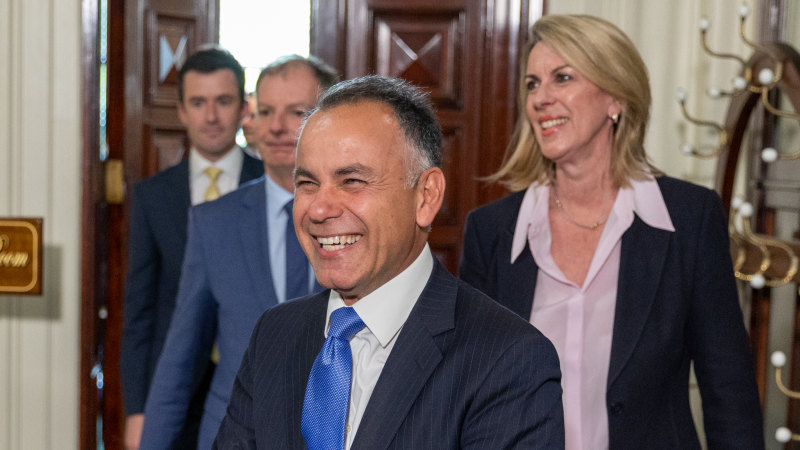Save articles for later
Add articles to your saved list and come back to them any time.
Employers are changing their attitudes about older workers, adjusting their view of what age really is old and increasingly recognising that mature workers are often more reliable, committed and able to cope with stress.
This is reflected in research by the Australian HR Institute and Australian Human Rights Commission, which found many organisations in 2023 defined “older” employees 61-65 years of age, whereas in 2021 the benchmark was more likely to be 50-55.
Lyn Tuit, a marketing and communications executive and board chair, says it’s an advantage for workplaces to have a wide demographic profile among their employees.Credit: Flavio Brancaleone
The institute’s fifth survey on attitudes to age among employers – to which 297 HR professionals replied – found fewer employers now put an age limit on those they are willing to hire.
When its regular surveys began in 2014, more than half of employers (52 per cent) had a cut-off age, but by February this year only 18 per cent had age limits.
But age-related bias continues to exist about older and younger workers, including views that younger workers are less resilient and older workers not as good with technology.
Only one quarter of employers were open to hiring workers aged over 65 “to a large extent”, while one in six organisations (18 per cent) said they would exclude candidates aged 65 or over from recruitment entirely, despite the fact two-thirds of the HR professionals said they were having difficulty finding staff.
The report, out on Monday, noted that there were 439,000 vacancies in the Australian economy in February 2023 – nearly double the pre-pandemic figure.
Nationally, the workforce grew by nearly 491,000 workers between October 2019 and October 2022, of which 186,000 – or 38 per cent – were aged over of 55.
Professor Marian Baird, head of the Discipline of Work and Organisational Studies at the University of Sydney, said it was positive to see some changing attitudes from employers on age, “however, it’s very disappointing to still see discrimination occurring.”
“Over 50-women’s employment is the most significant growth in Australia’s labour force. This is also positive, but only if they are treated well and can find good quality, flexible work that recognises all the care demands many have,” she said.
Gerwyn Davies, research and policy specialist at the HR Institute, said only four per cent of the growth in employment is among workers aged 55 and above, but they make up 20 per cent of the workforce.
“They have not kept pace with other age groups [in the past year]. This is a massive shift,” he said.
The slowdown was possibly because employers were trying to get workers back into offices, and mature workers preferred flexibility, or due to the large influx of overseas workers to Australia.
“Increasing longevity is forcing people to recognise they need to work for longer, and we are seeing growing willingness of employees to take on older staff,” Davies said.
“The perception of what constitutes an older worker has risen, which is good news from the point of view of both employers and employees.”
The survey found the majority of employers think older workers are stronger on loyalty, attendance, durability and “awareness”, while younger workers had better “physical capability, ambition and proficiency in using technology”.
“Many respondents surveyed report no difference between older and younger workers in terms of job performance, concentration, ability to adapt to change, energy levels and creativity,” it noted.
As longer life means Australians need more savings, Age Discrimination Commissioner, Kay Patterson, said it was positive that 73 per cent of employers had employed older workers in the past year.
Employers think older workers are more resilient but less technologically savvy, stereotypes that Kay Patterson says must be broken.Credit: Shutterstock
Changes imposed on the Australian workforce by the pandemic, when flexible work became accepted, had helped employers realise older workers had similar skill levels to younger peers.
“We need to debunk the myths ageism perpetuates and encourage employment across ages: sometimes employers are discriminating against younger people who have ‘not got enough experience’, so it’s not just going one way,” said Patterson, a former senator.
Marketing and communications executive, and chair of Alliance Francaise de Sydney, Lyn Tuit said she had not experienced ageism in the Australian workplace, and that the combination of younger and older people in teams benefits both groups, and their employer.
“One of the joys of working with a younger team is both parties bring something,” said Tuit, who describes her life-stage as at the begging of her 70s.
“What an employer gets is someone who’s likely to stay, is not on the ladder upwards, so has longevity [at that workplace], and who will be able to mentor younger staff … and provide an alternative point of view.”
A key to maintaining workplace currency is embracing new technology, she said, and staying “up to or nearly up to” levels of proficiency younger workers have.
That discrimination against hiring older workers continues at nearly one in five organisations was “inexplicable” in the face of staff shortages, said Sarah McCann-Bartlett, Australian HR Institute chief executive.
She said it “does not match up with the reality” in workplaces that skills and experience of different age groups complement each other, benefiting the organisation.
“The research shows the perception of [HR] respondents is that older and younger workers have different skill sets, and that creates a more diverse workforce and provides the ability for older workers mentoring younger workers and vice versa,” she said.
The workforce participation rate of people aged 55 to 64 jumped to 69.4 per cent in 2023, up from about 45 per cent in 1995. This historically high figure is part of an ongoing trend for the workforce participation rate of people aged over 55 to increase, the report noted.
The Morning Edition newsletter is our guide to the day’s most important and interesting stories, analysis and insights. Sign up here.
Most Viewed in National
From our partners
Source: Read Full Article




